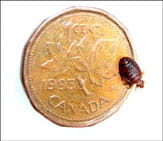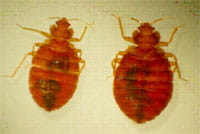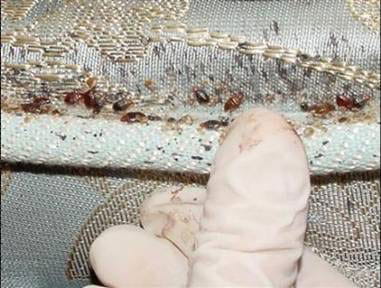What Are Bedbugs?
Bedbugs are small, flat, reddish-brown insects about the size of a lentil or apple seed.
Bedbugs get their name because they like to hide in the cracks and crevices of a bedroom or sleeping area.
Before World War II, bedbugs were common throughout the United States. Bedbugs have made a come back since the early 1990s because pesticides have changed, people travel more often and used furniture is more common. Bedbugs can be found around the world - in resort hotels, universities, cruise ships, homes and apartment complexes.
Bedbugs have even been found in Egyptian tombs dating back more than 3,000 years. Bedbugs do not care where they live. They can live in either a clean or a dirty environment. You are just as likely to find them in a world-class hotel, or anywhere where people rest or sleep.
Like mosquitoes, bedbugs feed on blood from animals or people during the night and hide during the day.

A bedbug compared to the size of a coin. Photo provided by the Center for Urban & Community Studies, University of Toronto.
Spread of Disease and Bedbugs
Bedbugs are not known to spread disease to people. Itching from the bites, though, can be so bad that some people will scratch enough to cause breaks in the skin that may get infected. The bites can also cause an allergic reaction in some people. If your child has some bites and you are concerned they may be from bedbugs, you should have them checked out by their healthcare provider.

Bedbugs are reddish-brown and about the size of a lentil. Photo provided by the Center for Urban & Community Studies, University of Toronto.
Spread of Bedbugs
Bedbugs can hitch-hike on items such as used furniture, luggage from a recent trip, clothing, pillows, boxes and other items that are carried from place to place. Bedbugs do not fly or jump, but they do crawl.Signs of Bedbugs
The first sign of bedbugs may be:
- The bugs themselves, especially along the seams of mattresses
- Tiny bloodstains on sheets and mattresses
- Small dark spots where bedbugs might crawl into hiding places on furniture, walls and floors
- A sweet odor where bedbugs are found in large numbers
Before taking any actions, call your local health department or a licensed professional pest control operator to make sure they are bedbugs and not some other insect.
Hiding Places of Bedbugs
During the day, bedbugs are most likely found hiding in cracks and crevices, usually near a bed or other sleeping area. Some hiding places are:
- Mattress and box spring seams, creases, tufts and folds
- Cracks of bed frame and headboard
- Under chairs, couches, beds and dust covers
- In laundry or other items on the floor
- Behind electrical plates and under loose wallpaper, paintings and posters
- In cracks in plaster
- In telephones, radios, TVs and clocks

Bedbugs hiding in the seam of a mattress.
Treatment for Bedbugs
Call your local health department or a licensed professional pest control operator for help. If you choose to treat the bedbugs with an insecticide, call a licensed professional pest control operator. Do not try to take care of this on your own.
Some guidelines to deal with bedbugs:
- Reduce clutter to limit hiding places for bedbugs.
- Do not bring used furniture into the home unless it can be visually inspected both inside and out as being bedbug free.
- It is important not to abandon infested furniture and mattresses without first marking them as "infested with bedbugs."
- Vacuum furniture, carpet and bedding. Be sure to vacuum cracks in wood doors or floors where bugs may hide. Dispose of vacuum cleaner bag in sealed plastic bag.
- Enclose the mattress with a special bedbug cover. Bedbugs inside the cover will be unable to feed and will die.
- Wash clothes and bedding in hot water and dry them with the hot cycle of the clothes dryer.
- To prevent bedbugs from crawling onto a bed, pull the bed frame away from the wall, tuck sheets and blankets so they don't contact the floor.
Prevention of Bedbugs from Traveling
- Hang clothing in the closet farthest from the bed.
- Place luggage on the folding luggage rack, not the bed.
- Place luggage in the dry-cleaning bag and tie ends shut.
- Check your clothing and luggage before you leave for home.
Getting rid of bedbugs may be difficult, and do-it-yourself actions can be dangerous and sometimes cause more harm than good. If you need help, call your local health department and get the help of a professional pest control service.



